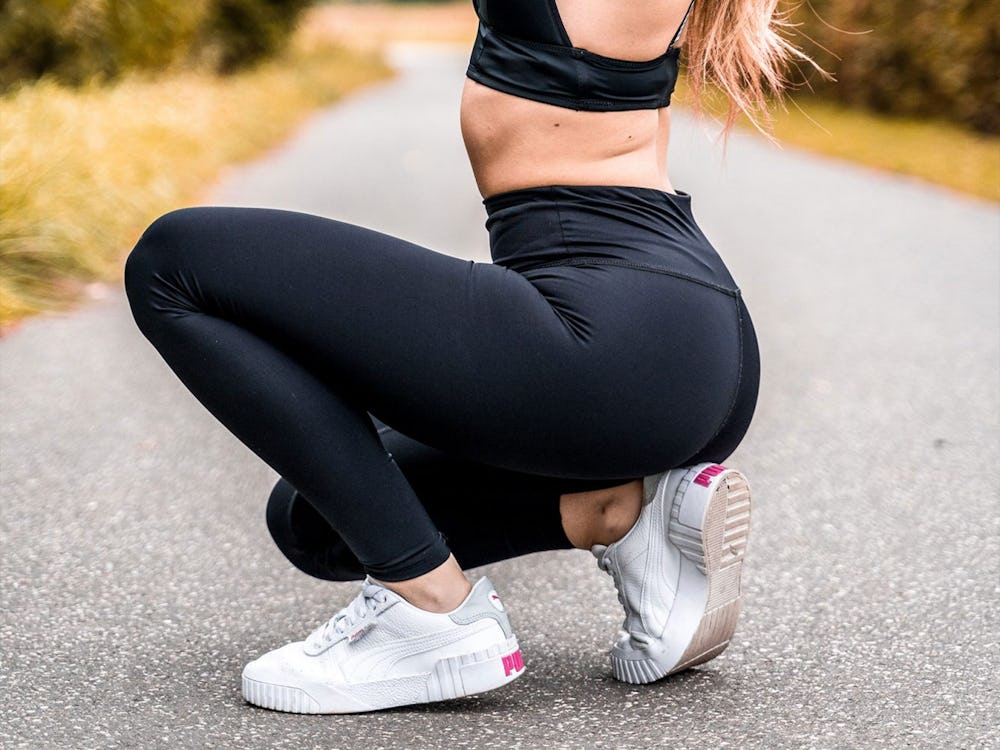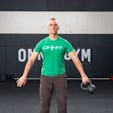The glute-ham raise is probably the most efficient hamstring exercise you can do. The catch? It’s also the most difficult. But if you have a glute-ham bench, this tutorial will help you master the movement in short order (and if you don’t, read on, and we’ll show you how to get the same benefits with other equipment).
Summary
– The glute-ham raise trains the hamstrings‘ two key functions simultaneously.
– Sets of 5–8 reps may be appropriate to start; later, the glute-ham raise can be trained with low-, moderate-, and high-rep ranges.
– The glute-ham raise movement can be approximated with the Nordic hamstring curl, and other variations that don’t require a glute-ham bench.
What Is the Glute-Ham Raise?
(See 00:23 in the video above.)
The glute-ham raise is a posterior-chain exercise. That is, it trains the muscles on the back side of the body that work together in unison. The hamstrings, however, get hit the hardest. The glute-ham raise is unique in that it works the hamstrings’ two functions—bending the knees and extending the hips—in one fluid movement, and through a full range of motion. We’ll explain in detail how to perform it below, but to get a sense of how the glute-ham raise is done, picture starting off with your torso parallel to the floor, and using the back of your legs to lift your entire body up until it’s perpendicular to the floor. (If that sounds hard to do, well¦ it is!)
There are only a handful of exercises that mimic the glute-ham raise movement (we’ll show you how to do some of them below, if you don’t have a glute-ham bench). Without them, you would need to perform multiple different exercises to achieve complete hamstring development. For instance, leg curls to work the knee flexion component, and Romanian deadlifts or kettlebell swings to train hip extension. So, glute-ham raises maximize efficiency. They also train the hamstrings in a very functional way that’s perfectly suited to faster running and overall lower-body explosiveness.
Think of how your foot strikes the ground during a sprint. Your hamstrings help to pull it underneath and behind your hips, and bend the knee, to propel your body forward. Powerlifters and weightlifters—guys and gals who need strong posterior muscles to lift the heaviest weights—also flock to the glute-ham bench. Glute-ham raises are a powerful assistance exercise for building up your numbers on the squat, deadlift, and clean.
And that’s why they were originally created. Glute-ham raises were first implemented by weightlifters in the U.S.S.R. sometime in the 20th century. Soviet athletes dominated the world stage in many different sports for decades. In the 1970s, when American weightlifter Bud Charniga was studying up on Soviet training methods, he discovered the glute-ham raise, and brought it to the States. Unable to find a bench that would allow him to perform it, Charniga mocked up his own using a pommel horse and a car seat. Specially-designed glute-ham benches have since become staples in serious strength and conditioning facilities, and are used by different kinds of athletes of all levels.
How to Properly Execute A Glute-Ham Raise
(See 01:05 in the video.)
We asked Clifton Harski, Director of Education for the Pain-Free Performance Specialist (PPSC) certification, to explain how to do a perfect rep.
Step 1. Glute-ham benches have a foot plate that is adjustable, and many have adjustable ankle pads as well. The foot plate can slide closer to and further away from the big pad that your hips rest on, and the ankle pads can be elevated or lowered. You’ll have to take a few minutes to experiment with setups until you find one that’s comfortable.
Ultimately, you want the foot plate far enough away from the pad so that, when you climb onto the bench, your knees can hang below the pad. The height of the ankle pads should be set so that your shins are angled slightly upward when your feet touch the plate and your torso is vertical (the top of the movement).
When you slide your feet between the ankle pads, your toes should touch the foot plate. Make sure these pads are secure, as they’re about to support your bodyweight. Try to get your feet to point straight down at hip-width distance, but you may find that you need to turn your toes out a few degrees to perform the exercise. Use your hands on the big pad to push your body up until it’s vertical. Draw your ribs down, take a deep breath into your belly, and tuck your pelvis slightly so it’s perpendicular to your spine. Brace your core.
Step 2. From this tall kneeling position, slowly extend your knees to lower your body. When your torso is parallel to the floor, bend your hips slightly so that it dips a few inches below parallel. You want to use as big a range of motion as you can, but without taking tension off your hamstrings. For that reason, don’t bend so much that your head points toward the floor. And whatever you do, don’t let your lower back round. Stay rigid.
Step 3. Extend your hips and drive the balls of your feet into the foot plate, allowing your heels to rise off the plate. Push through the big pad and bend your knees to pull your body back to vertical. This should look similar to how your leg works when it’s running. (You drive off the ball of the foot while the hamstrings are extending the hips and curling the leg.)
You can cut the range of motion a little short, stopping slightly before vertical, if you like. This is a good technique for targeting pure muscle gain, as the tension won’t subside at either end of the range of motion.

The glute-ham raise is relatively simple to perform, but because it’s foreign to most people, it’s liable to pose some problems at first. If you notice your calves cramping up, it’s a sign that you’re setting up with your upper body too far in front of the pad. This is making your calves work harder than they should to pull you back up. Move the foot plate more rearward, and check to see that your knees are pointing out below the bottom of the pad at the top of the exercise. If your bench doesn’t adjust to the right position for you, fold a towel over the hip pad, or drape a rubber mat over it, to add a little more mass to the pad and position your body further back. An inch or two can make a big difference.
Another common mistake is lowering your body until your torso is perfectly parallel to the floor. This shortens the range of motion a little bit, but it’s also the hardest position in the range, and it puts you at the greatest leverage disadvantage. When you’re just starting out on glute-ham raises, it pays to lower your body a little deeper so your hips flex; then you can use a bit of stretch reflex to come out of the bottom position. This makes the lift safer and will allow you to get more reps.
Finally, avoid hyperextending your spine on the way up. As your hamstrings tire out, you’ll have a tendency to want to finish the lift by arching your back hard. This can cause injury, so remember to keep your ribs down and your core tight.
“The glute-ham raise can provide such a large overload directly to the glutes and hammies—without a substantial lower-back strength demand—that it can serve as the big strength move for those muscles for most people,” says Harski. “It can actually replace the deadlift for a period of time. It is important to train the posterior chain aggressively and often, but to do so while minimizing loading of the spine, specifically the lower vertebrae.” In other words, the glute-ham raise can play a key role in strengthening your lower body without risking injury to the lower back in the way heavy deadlifts and back squats can. While it’s a simple bodyweight movement, the glute-ham raise packs a similar punch to big barbell exercises.
Once you’re experienced with it, the glute-ham raise can be trained through several different rep ranges. You may need to use sets of 5–8 reps at first, because the exercise is so challenging, but within a few weeks, you will likely be able to do it for 8–12 reps, treating it like you would most other assistance exercises that are done with moderate weight for moderate reps. If you’re pretty strong on glute-hams, or want them to serve as a substitute for a big barbell lift such as the deadlift, you can add resistance by holding a weight plate to your chest or wrapping a band around the feet of the bench and the back of your neck, allowing you to train in the 5–8 rep range again.
As your own bodyweight becomes easier to manage, you can do glute-ham raises for sets of 20 or more reps, which can serve as a brutal finisher for your leg day.
What Muscles Do Glute-Ham Raises Work?
(See 03:28 in the video.)

The glute-ham raise focuses on the hamstrings, but the tension it creates on the back side of the body irradiates all the way up the chain. That means that the glutes get involved as well (as the name of the exercise would imply), along with the spinal erectors, which run from the pelvis all the way up to the neck. The ab muscles also have to work with your erectors to brace your spine, so it doesn’t flop over while you perform the raise. And don’t be surprised if you wake up with some calf soreness the day after doing glute-ham raises the first time, since the gastrocnemius activates to assist the hamstrings in flexing the knee.
If you really want to nerd out, tell your friends that you’re training your semimembranosus, semitendonosis, and biceps femoris, aka, the leg biceps. (These are the three hamstring muscles, from the medial side of the leg to the lateral side.) All three muscles originate on the lower portion of the pelvis and insert below the knee, which gives them a unique ability to bend the knee and extend the hips at the same time. Imagine doing a machine leg curl but without the machine to support your hips. You’d have to keep them from bending while you flexed your knees. In the glute-ham raise, you have to do this against the resistance of your bodyweight—which is far more than what you can load on a leg curl machine. Now you see why glute-hams are such a ruthless move for the hamstrings.
Can I Do the Glute-Ham Raise Without A Machine?
A glute-ham bench is the best option for performing the glute-ham raise movement safely, but if you don’t have access to one, you can mimic it with other equipment. The Nordic hamstring curl, typically done with a barbell or regular utility bench, is a challenging but suitable substitute exercise. That said, it is even HARDER than the glute-ham raise, and definitely not for beginners. However, if you’ve been training a while and are confident in the strength of your hamstrings, give it a go.
Nordic Hamstring Curl
Step 1. Load a barbell on the floor and wrap a pad or towel around it to protect your ankles. Place a pad or mat on the floor to save your knees. Kneel on the pad and secure your ankles under the bar. (You can also use a bench that’s secured to the floor, or the spotter bar in a power rack, or have a partner hold your ankles down).
Step 2. Tuck your pelvis so it’s perpendicular to your spine. Take a deep breath into your belly, and brace your core. Have your hands ready at your sides so that you can catch yourself if you lose control on the descent. Bend your hips back so your torso leans forward a little—maintain this hip position throughout the set.
Step 3. Begin extending your knees, lowering your body toward the floor under control. When you feel you can’t maintain tension in your hamstrings anymore, let your body fall and break your fall with your hands. The range of motion won’t be great, but the extreme tension you create in your hamstrings will still make the exercise effective.
Step 4. Push off the floor and try to perform a glute-ham raise to return to the starting position.
You will probably only be able to manage a few negative reps at first (just the lowering portion of the movement). Build up to where you can perform full reps, and gradually increase your range of motion from there. (That is, aim to use less assistance from your hands over time.)
Harski says you can try using a physioball as well—the big inflatable ball most people use for situps and other ab exercises.
“Place the ball under your thighs and anchor your feet under a stable bench,” says Harski. Make sure the bench is secured to the ground—you may have to weight its feet down. The movement is done the same as the glute-ham raise and Nordic curl.
Yet another option is to use a Bosu ball, which looks like half a physioball (dome on one side, flat on the other). Kneel on the edge of the inflated dome side and press your feet against a wall, driving primarily through the balls of your feet. Perform the Nordic curl movement, using your hands on the floor to push yourself back up if you can’t make it through the full range motion.
Great GHR Alternatives
(See 03:57 in the “Perfect Your Glute-Ham Raise” video at the top.)
If you don’t have a glute-ham bench, and you aren’t inclined to build a DIY one, you can still work your hamstrings and glutes hard with exercises that train these muscles in a similar fashion and are doable at home.
Slider Hamstring Curl
(See 04:35 in the video.)
Sure, you’ve done hamstring curls, and they’re nowhere near as powerful as the glute-ham raise, but they can be with a small tweak. What we miss in an isolated hamstring curl is the hip extension we get in a glute-ham raise. One easy way to bring both knee flexion and hip extension together is to do a leg curl motion with furniture sliders, which allow you to drive your feet into the floor to raise your hips first, followed by sliding your feet toward your butt for knee flexion.
Sliders can be bought in any hardware store. They’re cheap, effective, easy to store and carry in a gym bag, and have a myriad of uses. The only catch is that you need to be on a smooth waxed floor, turf, or carpet to use them. Rubber flooring can cause too much friction and make the move overly difficult or even impossible.
Step 1. Lie on your back on the floor and place the sliders under your feet. Bend your knees and slide the sliders in close to your butt. Tuck your pelvis slightly so that it’s perpendicular to the floor and take a deep breath into your belly. Brace your core. Drive the back of your arms into the floor at a 45-degree angle to your torso to add stability.
Step 2. Push through your heels to raise your hips up to full extension. Keep your core tight so you avoid arching your lower back.
Step 3. Slowly extend your knees, sliding your feet out in front of you as you lower your hips. Stop just short of where your butt would touch the floor. When your legs are extended, reverse the motion, curling your legs as you bridge your hips again.
Banded Rolling Hamstring Curl
(See 05:35 in the video.)
One way around the stickiness of sliders is to use a glute-ham roller or glider. It works the same as sliders but offers a platform to rest your feet on and wheels that roll it, making it usable on any flooring.
With any sliding leg curl variation you do, start by adding reps to progress the challenge. When you can do several sets of 10 or more, you’ll need to add resistance, which you can easily do by adding an elastic exercise band around your ankles. The band will amplify the concentric portion of the exercise (pulling the heels back), and make you work to stabilize yourself on the eccentric (extending your legs).
Step 1. Attach a light band to a sturdy object and wrap the open end around the back of your heels. Lie on your back on the floor and rest your heels on the roller.
Step 2. Perform the movement as you would the sliding curl described above.
Note: There are still more options that will allow you to perform the same sliding/rolling hamstring curl movement. A suspension trainer and a physioball can also be used.
Leg-Banded Ab Rollout
You’re probably familiar with rollouts done on an ab wheel. By adding a band around your feet, you can make a standard rollout into a posterior-chain exercise that nearly replicates the glute-ham raise while you train your core at the same time. The band forces you to maintain hip extension while you flex the lower leg, just as a glute-ham raise does.
Step 1. Anchor a band to a sturdy object and place a towel, mat, or pad on the floor to protect your knees. Kneel on the pad and hook the band around the back of your ankles. Curl your heels toward you to 90 degrees, so that there’s tension on the band, and you feel your hamstrings engage. Hold an ab wheel on the floor directly under your shoulders (or use a barbell loaded with light plates so it can roll, as shown above). Your body should form a straight line from your head to your knees, with your core braced.
Step 2. Roll the wheel forward, extending your hips while maintaining a tight core and alignment between your spine and your pelvis. Maintain the isometric hold in your legs. From the end position, draw the wheel back into the floor and return to the starting position. That’s one rep.
Back Extension and Leg Curl
If you don’t have the equipment to address both knee flexion and hip extension in one solid move, performing each of the movements separately is enough to ensure that you at least don’t skip training one of the hamstrings’ key functions. Though its name is something of a misnomer, the back extension exercise done on a 45-degree back extension bench trains hip extension. Do a few sets followed by leg curls—seated, standing, or prone—and you’re giving the hamstrings the one-two punch they need to grow and strengthen to their potential.
Back Extension
Step 1. Adjust the pad of a back extension bench so that it fits in the crease of your hips when you mount the bench. Get on the bench, and secure your feet under the ankle pads. Tuck your pelvis so it’s perpendicular to your spine, and brace your core. Your body should form a long, straight line.
Step 2. Bend only at the hips to lower your torso toward the floor. Stop before you feel your lower back is about to round forward. Squeeze your glutes as you extend your hips and return to the starting position.

)





